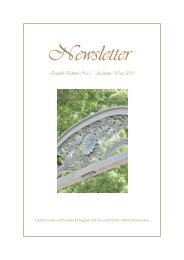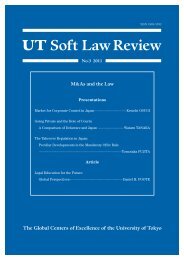<strong>UT</strong> <strong>Soft</strong> <strong>Law</strong> <strong>Review</strong> No.2 2010that would be created shortly after the Guidelines were issued. 2Unlike the Delaware model, which had over 30 years to evolve, Japan had no model inplace, since until 2001 it never experienced hostile takeovers. Presumably the expectation ofMETI, MOJ, and the CVSG was that the Guidelines would enable Japan either to bypass, or toaccelerate at light-speed, the development of its own model by transplanting the Delawaremodel to Japan. The important question that the Guidelines implicitly raised was whetherthis assumption would prove to be accurate; that is, whether Japan’s courts would create acommon law anti-takeover regulatory regime resembling that of Delaware, or whether Japan’sregulatory scheme would develop its own unique characteristics. That question was thesubject of a paper that I delivered at the University of Tokyo School of <strong>Law</strong> in 2005. In thatpaper I predicted that in developing its own takeover jurisprudence, Japan would experiencea unique doctrinal evolution that might—or might not—resemble that of Delaware. 3Today, Professor Curtis Milhaupt, of Columbia <strong>Law</strong> School, and I again find ourselves inTokyo, to participate in this Symposium to assess the future direction and form of thatevolution. What has happened in Japan since the Guidelines were first adopted? We knowthat between 2005 through 2007, over 400 Japanese companies adopted takeover defensemeasures. 4 We know that during that period, there were roughly ten hostile bids for Japanesecompanies, some of which resulted in Japanese court decisions. One decision—which aroseout of Steel Partners’ 2007 hostile bid for Bull Dog Sauce, 5 marked the first significant fork in2 Two legislative changes took place during this period. The first was a disclosure rule for defensivemeasures promulgated by the MOJ. See Article 127, Ministry of Justice Companies Act ImplementationRule (2005). The second was an amendment in 2006 of the Securities and Exchange Act (“SEA”) thatrelevantly approved a poison pill defense using a trust structure and authorized the Financial ServicesAgency (“FSA”) to make detailed rules relating to tender offers. One of those rules permits the targetcompany board to ask the bidder questions, which the bidder must answer in their public documents.Another was an EU style mandatory bid rule, which applies only where the bidder attempts to acquire 2/3or more of the target company shares. In addition, the Tokyo Stock Exchange adopted administrativecertain rules and guidelines. Hideki Kanda, Takeover Defenses and the Role of <strong>Law</strong>: A JapanesePerspective (March 31, 2008), Manuscript at 5-6 (cited herein as “Kanda”).3 Jack B. Jacobs, Implementing Japan’s New Anti-Takeover Defense Guidelines Part I: Some LessonsFrom Delaware’s Experience in Crafting “Fair Takeover Rules, 2 NYU Journal of <strong>Law</strong> & Business, 323,350 (2006) (cited herein as “Jacobs, Lessons from Delaware”).4 Report, Takeover Defense Measures in Light of Recent Environmental Changes (Corporate ValueStudy Group, June 30, 2008) at 2 (reporting that “more than 500 Japanese companies have adoptedtakeover defense measures”); Curtis J. Milhaupt, Bull-Dog Sauce for the Japanese Soul? Courts,Corporations, and Communities—A Comment on Haley’s View of Japanese <strong>Law</strong>, (May 5, 2008)unpublished draft article, forthcoming in ___L. Rev. __(2008) (cited herein as “Milhaupt, Bull DogSauce.”) at 1 (“about 400 publicly traded Japanese firms have adopted some form of shareholder rightsplan” and describing the form of those plans as “highly unusual”); Ronald Dore, Japan’s conversion toInvestor Capitalism, (August 16 2008), unpublished draft article, forthcoming in ___ L. Rev. ___(2008)(cited herein as “Dore”) at 4 (“About 400 firms have adopted such measures.”).5 Steel Partners Japan Strategic Fund (Offshore), L.P. v. Bull-Dog Sauce Co., Ltd., 1805 Shoji Homu43 (Tokyo D. Ct., June 28, 2007) (“Bull-Dog Sauce I”); 1806 Shoji Homu 40 (Tokyo High Ct., July 9, 2007)11
<strong>UT</strong> <strong>Soft</strong> <strong>Law</strong> <strong>Review</strong> No.2 2010the road of that evolution. The Bull-Dog Sauce case, which was decided by three differentJapanese courts—a trial court and two appellate courts—generated two quite differentapplications of the Guidelines and, thus, two quite distinct rationales for upholding theparticular anti-takeover defense in that case.That divergence of views within the Japanese judiciary raised three questions. First, didthe original Guidelines give sufficient guidance to the judiciary presumably being chargedwith their application and enforcement? Second, given Japan’s unique business and legalculture, is the Delaware-style common law judicial lawmaking approach the most appropriateto regulate Japanese board responses to hostile takeovers, or is that better accomplished bylegislation, administrative rulemaking, or some combination thereof? And third, if theJapanese judiciary is the appropriate rule-making institution, how will the judges allocate thedecision-making power as between the directors and the shareholders of Japanese targetcompanies, and what will be the standard for judicial review of Japanese anti-takeoverdefensive board conduct?The first question prompted the CVSG to issue a Supplemental Report that apparently wasintended to offer the Japanese courts further guidance as to how (in the CVSG’s view) theGuidelines should properly be interpreted and applied in various circumstances, includingthose involved in Bull Dog Sauce. 6 The second and third questions, however, remainunanswered and form the subject of what we will be discussing today.Before doing that, allow me to answer one question that you are likely asking yourselves:what do I, an American judge who is not a Japanese law scholar, bring to this discussion? Icertainly claim no special expertise from the Japanese legal perspective. That expertisebelongs to Professor Milhaupt, who is one of America’s most prominent Japanese <strong>Law</strong>scholars, and with Professor Hideki Kanda, who is perhaps Japan’s preeminent Japanesecomparative corporate law scholar. Both of these gentlemen will grapple with these issues intheir own remarks, which follow mine. My goal is far more modest: to set the stage for theirremarks by recounting how the American institutional framework for expounding andenforcing takeover rules evolved under U.S. federal securities law and Delaware fiduciary law.My hope is that Japanese policymakers may find Delaware’s experience useful in decidingwhat Japanese institution or institutions should shape the future direction and form of Japan’stakeover jurisprudence.II. EVOL<strong>UT</strong>ION OF AMERICA’S ANTI-TAKEOVERLAW-MAKING INSTIT<strong>UT</strong>IONAL FRAMEWORKOne cannot meaningfully discuss the evolution of Delaware’s institutional framework forregulating anti-takeover board behavior without understanding the broader American(“Bull-Dog Sauce II”);; 1909 Shoji Homu 16 (Sup. Ct., Aug. 7, 2007) (“Bull Dog Sauce III”).6 On June 30, 2008, the Corporate Value Study Group published a Report entitled Takeover DefenseMeasures in Light of Recent Environmental Changes ( the “2008 Supplemental Report”). One of the“environmental changes” discussed in that Report was the trilogy of Bull-Dog Sauce decisions.12





